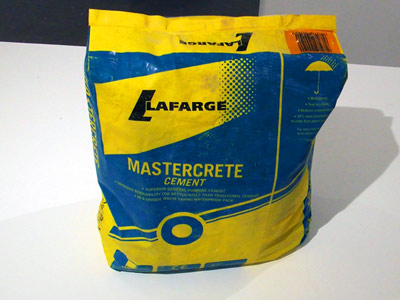joint projects
Lot 2


Cement
Bag containing processed limestone, clay, gypsum)
Concrete was at one time the most used product on the planet after water. At its peak in 2022, the manufacture of concrete accounted for an estimated 6% of the CO2 placed in the atmosphere by human activity.
By the beginning of the 21st century, however, the industry faced a cap on its emissions under what was then known as the ‘emissions trading scheme’ – part of a now discredited market-based approach to maintaining a growth economy with little structural change.
Up until this time, a small group of highly influential ‘experts’ in ‘traffic management’ (a minor branch of engineering), had used this cut-price material to create more traffic to engineer for.
As the Peak Depression neared and people abandoned personal travel for public transport schemes, the space that traffic management had previously appeared to need was seized in the cause of much needed local urban food production.
Nothing can be seen as more emblematic of these times than the Westway in London, closed to make way for the Westway Hanging Gardens allotments project.

Provenance
Despite their low public profile, the cement firms responsible for making concrete have come under increasing political and public pressure to reduce their climate changing emissions. To understand the scale of the problem, in 2006 China’s demand for building materials meant that cement production released almost the same amount of carbon dioxide as Britain’s total output from all sources. 1
Like many polluting industries facing the threat of tougher government regulation and growing public concern, the cement industry has attempted to get on the front foot with a series of voluntary eco-measures under a programme known as the Cement Sustainability Initiative.
The Initiative is part of the World Business Council for Sustainable Development, a lobby group made up of more than 200 transnational businesses. It was set up to represent corporate interests at the UN’s crucial Earth Summit in Rio in 1992, an event it was accused of hijacking. Its aim today is to promote business as an environmentally friendly force in the world.
The Council claims that “business has made great progress” in this direction. But critics accuse it of trying to delay real action by opposing government measures to force businesses to act responsibly.
The Council’s former chairman, Livio DeSimone, reveals the group’s greatest achievement to date: “Business...used to be depicted as a primary source of the world’s environmental problems. Today it is increasingly viewed as a vital contributor to solving those problems and securing a sustainable future for the planet.” 2 A triumph of PR over substance.
So what does a sustainable future look like? Recent ‘sustainable construction’ demonstration projects in the UK include: a drive-through McDonalds, five giant superstores, a new motorway, part of a nuclear power plant and a cement works.3
1 David Adam, The unheralded polluter: cement industry comes clean on its impact,
The Guardian, 12 October 2007
2 World Business Council for Sustainable Development,Annual Review 1997
3 Part of New Labour’s ‘Rethinking Construction’ initiative, 1998